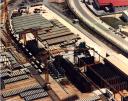Pre-stressed concrete
The manufacturing process comprises the following stages:
- Manufacture of steel cylinders
- Forming and expanding nozzles
- Cores made by radial compression
- Pre-stressing
- Outer coating
- Curing the coating
Manufacture of cylinders
Cylinders are made up of a cylinder of steel plate lap welded in a spiral by an automatic machine from coils of metal steel and with a width equal to or greater than one metre. The corresponding ‘male’ or ‘female’ ends are welded to these cores, allowing for proper dimensional tolerances.
Once the cylinders have been formed, they are placed on turning gear and nozzle pieces coupled to the ends. These nozzle ends are pre-tested by cross-welding with penetrating fluids and clamped around the outside of the cylinder. Inspection of their dimensions is mandatory.
Once the cross welding of the joint between heads has been made, each cylinder is subjected to hydraulic internal pressure testing in a horizontal press.
Forming and expanding nozzles
Depending on the requirements of each project, the ends of steel cylinders may be fitted with nozzle pieces, made up of:
- A rolled profile for the rubber seal.
- A plate for the welded joint.
Flat plates of suitable size to form the nozzles are curved and the ends welded together. Then they are expanded in a purpose-built hydraulic press, thus achieving perfect dimensional control.
If the heads are to be fitted with an elastic joint, the material for the joint is first shot-peened and once formed geometrically, it is given a coat of primer protection and is fitted onto the pipe. Then it is coated with epoxy alimentary resin to guarantee its durability against any aggressive agent.
Radially compressed cores
Once the absolute tightness of the steel cylinder has been tested, it is stood vertically on a machined baseplate that forms the female nozzle.
A strong metal mould is fitted on the outside to absorb the stress on the steel cylinder during the radial compression.
The moulded unit is stood on the rotating bottom platform of the machine, which places it on the axis.
The upper part of the mould is clamped by a platform, which centres it on the machine axis, while a hydraulic cylinder lowers over it. This hydraulic cylinder has a rotary piston at the bottom end of the same diameter as the inner diameter of the concrete pipe. This cylinder descends to the position of the nozzle at the bottom end of the steel cylinder.
The combination of the piston’s rotational speed and its upward speed causes the concrete poured in the top to be compressed against the steel cylinder, where it is compacted to form a smooth surface over the entire length of the cylinder.
Once the upper platform mould is released, and the bottom mould loosened by turning it, the pipe is within reach of the bridge crane that transfers it into the indoor storage area, where the outer mould is removed for subsequent use on another steel cylinder.
The inner concreted steel cylinder remains into the storage area until the concrete attains high strength to be transported to the storage yard, where it is watered until it obtains the necessary strength to withstand the pre-stressing process.
Pre-stressing
When the concrete of the core reaches the required strength to withstand the compression induced by pre-stressing, hooping takes place.
Transversal pre-stressing is realised performed a strapper that wraps tensioned wire in a spiral around the core placed in a suitable position.
For this purpose, specially smoothed wire with a breaking strength of 18,000 Kg/cm2 and low relaxation is used. Wire diameters range between 5-7 mm. The machine is fitted with a tension log to display wire tension at all times.
Outer coating
Once the core has been pre-stressed, the steel is then protected by applying a 30 mm thick coating of concrete on the outer surface of the . A vibrating screed machine is used to do this.
The process involves turning the pipe horizontally while a layer of concrete is poured onto its top surface, which flows as a result of the high frequency vibration.
Adhesion is achieved due to the combined action of vibration and the compression produced when the concrete is forced to flow in the gap between the machine wall and the pipe.
Curing the coating
When the pipe comes out of the screed machine and until it is time to start watering it, the top surface of the pipe is protected.
Once enough time has elapsed to ensure the concrete cannot be damaged, it is subjected to intense water sprinklers so that the concrete is completely wet until it is shipped to the work site.


























